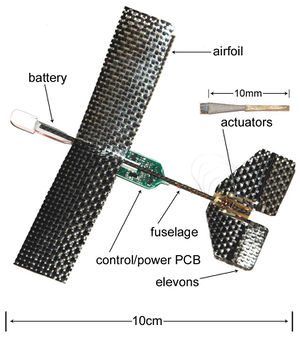Difference between revisions of "Media"
Jump to navigation
Jump to search
HectoPascal (talk | contribs) |
|||
| Line 4: | Line 4: | ||
== Paparazzi in the News == | == Paparazzi in the News == | ||
* [http://www.spiegel.de/wissenschaft/mensch/0,1518,525696,00.html SPIEGEL Online: Projekt "Paparazzi": Bau dir deinen fliegenden Spion]- December 28, 2007 | * [http://www.flightglobal.com/articles/2008/04/03/222680/cots-uav-makes-arctic-debut.html Flight International: COTS UAV makes arctic debut] - April 3, 2008 | ||
*:<small>A Norwegian university has flown an autonomous unmanned air vehicle equipped with meteorological sensors over the Spitzbergen/Svalbard island in the arctic circle in temperatures of -20 degrees C (-4 degrees F), winds up to 15m/s (50ft/s) and at an altitude of 4,900ft (1,500m). The Multiplex Funjet UAV was modified with electronics for open-source Paparazzi autopilot software… | |||
</small> | |||
* [http://www.spiegel.de/wissenschaft/mensch/0,1518,525696,00.html SPIEGEL Online: Projekt "Paparazzi": Bau dir deinen fliegenden Spion] - December 28, 2007 | |||
*:<small>Unbemannte Mini-Flugzeuge werden derzeit vor allem von Militärs genutzt. Doch eine Drohne, die selbständig vorgegebene Routen abfliegt, lässt sich auch selbst bauen. Für etwa 1000 Euro bekommt man ein Flugzeug, das sich bequem per Software dirigieren lässt. | *:<small>Unbemannte Mini-Flugzeuge werden derzeit vor allem von Militärs genutzt. Doch eine Drohne, die selbständig vorgegebene Routen abfliegt, lässt sich auch selbst bauen. Für etwa 1000 Euro bekommt man ein Flugzeug, das sich bequem per Software dirigieren lässt. | ||
*:Der Flieger macht nicht, was er soll: Plötzlich dreht er um 180 Grad und kehrt zum Startpunkt zurück. "Alles ist unter Kontrolle", sagt Antoine Drouin und die Zuhörer auf dem Chaos Communication Congress in Berlin lachen… | *:Der Flieger macht nicht, was er soll: Plötzlich dreht er um 180 Grad und kehrt zum Startpunkt zurück. "Alles ist unter Kontrolle", sagt Antoine Drouin und die Zuhörer auf dem Chaos Communication Congress in Berlin lachen… | ||
| Line 47: | Line 51: | ||
== Design Reports == | == Design Reports == | ||
* [http://www.iop.org/EJ/article/1755-1315/1/1/012014/ees8_1_012014.pdf SUMO: A small unmanned meteorological observer for atmospheric boundary layer research]<br><small>(751k, PDF) - May 2008 | |||
*: Paper describing the meteorological campaigns on Iceland and Spitsbergen.</small> | |||
* [http://www.recherche.enac.fr/paparazzi/papers_2008/ENAC_MAV08.pdf YAP - Yet Another Paparazzi]<br><small>(4M, PDF) - March 2008 | * [http://www.recherche.enac.fr/paparazzi/papers_2008/ENAC_MAV08.pdf YAP - Yet Another Paparazzi]<br><small>(4M, PDF) - March 2008 | ||
*: Technical paper of the ENAC entry at [http://www.nal.res.in/MAV08 MAV08]</small> | *: Technical paper of the ENAC entry at [http://www.nal.res.in/MAV08 MAV08]</small> | ||
Revision as of 10:59, 22 May 2008
Paparazzi in the News
|
Design Reports
Manuals
|
Other Sites of Interest
- "Design, Fabrication and Initial Results of a 2g Autonomous Glider"
(900K, PDF) - July 2007- Utilizing the core technologies of emerging microrobotic structures, the rapid design and prototyping of a passive micro air vehicle with the final goal of locating an audio source while avoiding hazardous obstacles is presented. The airfoil and control surfaces are optimized empirically to maximize lift and maneuverability while minimizing drag. Bimorph piezoelectric bending cantilevers actuate the control surfaces. Since such actuators require high voltages, an efficient boost circuit is presented along with appropriate high voltage electronics. To locate audio sources, a pair of acoustic sensors is designed and prototyped using a phase detection algorithm while a custom optic flow sensor is developed to avoid obstacles and give estimates of object distances and velocities. Finally, each subsystem is demonstrated and the complete glider is integrated to demonstrate initial open loop control performance.
